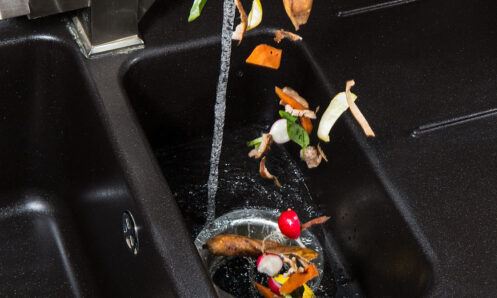
A garbage disposal is a crucial kitchen workhorse that helps prevent clogged drains. When it malfunctions, the kitchen immediately becomes a mess. Issues such as unpleasant odors, wastewater backing up into the sink, and an inability to efficiently dispose of food waste can quickly arise. Fortunately, troubleshooting a garbage disposal is easy. Here’s what you need to know.
Understanding a Garbage Disposal
A garbage disposal is a simple kitchen appliance that consists of a motor that powers spinning blades (commonly referred to as impellers). The impellers shred food waste into small pieces that can pass through plumbing with water. As a result, it helps to keep the sink clean and reduces the amount of trash headed to the landfill.
Reasons Why Your Garbage Disposal Isn’t Turning
Even if you know how to diagnose problems with your garbage disposal by yourself, it’s best practice to consult a qualified plumber. Some issues go beyond face-value observations and may require professional expertise. Common reasons for garbage disposal not turning include the following.
Jammed Impellers
Your garbage disposal may be refusing to turn because something is stuck between the impellers and the grinding ring. Food particles such as bones, fibrous vegetables, coffee grounds, and even rice could be the cause. It may come as a surprise, but rice, as soft as it is, can cling to the impellers and the grinding ring, forming a paste that hinders efficient turning. Also, non-food items like forks and spoons can fall inside and jam the blades.
Faulty Motor Bearings
Garbage disposals have a motor shaft—a rotating metal rod that acts as the central axis that spins the grinding blades. Motor bearings support this motor shaft. Bearings can wear out with time, making it difficult for them to effectively support the shaft. Hence, the blades won’t turn. Also, something can get lodged in the bearings, causing them to seize up and prevent the motor from spinning.
Power Supply Issues
Garbage disposals are often installed with a separate circuit breaker known as a ground fault circuit interrupter (GFCI). This is done primarily as a safety measure due to their proximity to water in the sink.
Garbage disposal motors tend to produce electrical noise (unwanted electrical signals) when running because of the high current they draw. This electrical noise can sometimes trip the GFCI, causing the garbage disposal to shut down.
Moreover, if you have loose wiring or a faulty switch, the garbage disposal won’t receive the necessary power it needs to operate. Checking the electrical connections and ensuring they are secure can resolve these issues. However, if the GFCI continues to trip, you may have a more significant electrical problem that requires professional attention.
Overheating Motor
Using your garbage disposal continuously for an extended period can cause the motor to overheat and trigger the overload protector. This safety feature, present in all garbage disposals, automatically shuts off the unit when it detects something is amiss. Let the system cool down before hitting the reset button (in color red) to reactivate it. If it refuses to turn on, let a qualified plumber examine it.
Old Age
The average lifespan of a garbage disposal is 10 to 14 years, with proper maintenance. A unit older than 10 years has several worn-out components that can sometimes just stop working. In such cases, it’s best to upgrade rather than repair.
Preliminary Checks Before Calling a Plumber
When your garbage disposal refuses to turn, first disconnect its power supply to prevent accidents or further damage. This precaution is necessary because you still don’t know the root cause of the issue. The appliance can reenergize unexpectedly and cause physical harm, or you could be electrocuted.
Use a flashlight to look inside the disposal for any visible obstruction. If you find anything, use tongs or pliers to remove it carefully. Do not use your hands, as the blades can cut you.
Next, check the circuit breaker. If it is off, flipping it back on may not be the best course of action since you don’t know why it tripped in the first place. This step will help you determine that the issue likely lies with the electrical system.
If you have a GFCI installed for the garbage disposal, try pressing the reset button. The GFCI can trip from minor overload issues, like electrical noise when you run the disposal continuously for extended periods.
Lastly, try manually turning the impellers from the bottom of the disposal using a hex key or Allen wrench to dislodge potential jams. If the impellers move freely but the disposal still doesn’t work, the problem might be bigger than you think. A plumber will help.
Professional Repair or Replacement
When a plumber arrives to repair your garbage disposal, be sure to explain the issue to them and the steps you’ve already taken in an effort to try to get it working again. They will proceed to diagnose the issue and fix it in an hour or two.
If system replacement is necessary, they’ll advise you on the best model for your home. The key features you should look for when buying a new garbage disposal include the following.
Motor Power
Garbage disposal motor power is measured in horsepower (HP). Basic models at the lower end of the price scale have 1/3 HP motors. They can serve you for a short while or if you live by yourself and use them infrequently.
1/2 to 3/4 HP garbage disposal motors tend to last longer than their less powerful counterpart. They can grind small bones and most vegetable and fruit waste. Consider them if three to four people live in your house.
The best models have 1HP motors. They have a larger capacity for food waste, can be used continuously, and they barely jam.
Noise Level
It’s important to look for garbage disposals that operate quietly. Search for models with SoundSeal technology. This technology includes features such as an “Anti-Vibration Mount and Tailpipe Coupler” to minimize vibration, a “Quiet Collar Sink Baffle” to block noise from the sink, and a “Sound Jacket” that traps noise from the garbage disposal itself.
Anti-Jamming Features
Consider a unit that prevents the blades from refusing to turn. Modern garbage disposals have features such as jam sensors that detect excessive torque and adjust power to prevent blockages. They also have auto-reverse functionality that automatically reverses the grinding mechanism to dislodge jams, and drain boost technology that forcefully flushes water down the drain with the waste.
Size
You should purchase a system that fits nicely under your kitchen sink and within your cabinet space. Measure the area under your sink and use those dimensions as a guide when shopping for a new disposal. This will help make the installation, repair, and maintenance processes easier and ensure the unit functions efficiently without crowding the plumbing or other fixtures.
Contact Rosenberg Plumbing & Air for More Information
Don’t hesitate to reach out to us for all kinds of garbage disposal issues you encounter. We are a full-service plumbing services company that has proudly served San Antonio for over 37 years. Our experts will diagnose and fix your issue quickly and thoroughly with as little disruption to your home and activities as possible. You can also contact us for HVAC system repairs, installation, and maintenance, as well as for indoor air quality solutions.
Call Rosenberg Plumbing & Air today for garbage disposal repairs or replacements in San Antonio.
Tags: garbage disposal repair, garbage disposals
